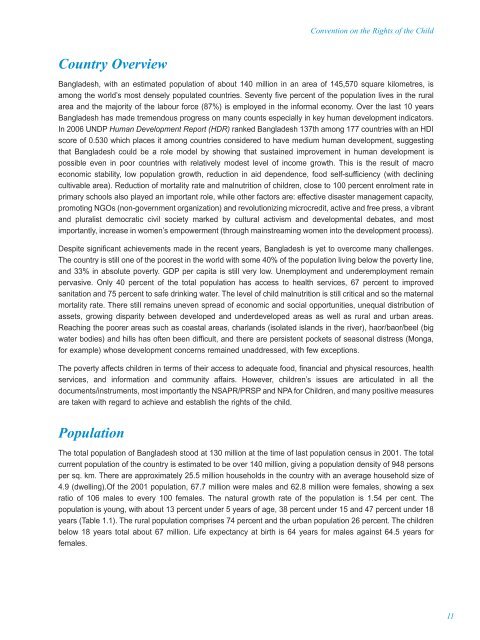Third and Fourth Periodic Report on CRC - Unicef
Third and Fourth Periodic Report on CRC - Unicef
Third and Fourth Periodic Report on CRC - Unicef
Create successful ePaper yourself
Turn your PDF publications into a flip-book with our unique Google optimized e-Paper software.
C<strong>on</strong>venti<strong>on</strong> <strong>on</strong> the Rights of the Child<br />
Country Overview<br />
Bangladesh, with an estimated populati<strong>on</strong> of about 140 milli<strong>on</strong> in an area of 145,570 square kilometres, is<br />
am<strong>on</strong>g the world’s most densely populated countries. Seventy five percent of the populati<strong>on</strong> lives in the rural<br />
area <str<strong>on</strong>g>and</str<strong>on</strong>g> the majority of the labour force (87%) is employed in the informal ec<strong>on</strong>omy. Over the last 10 years<br />
Bangladesh has made tremendous progress <strong>on</strong> many counts especially in key human development indicators.<br />
In 2006 UNDP Human Development <str<strong>on</strong>g>Report</str<strong>on</strong>g> (HDR) ranked Bangladesh 137th am<strong>on</strong>g 177 countries with an HDI<br />
score of 0.530 which places it am<strong>on</strong>g countries c<strong>on</strong>sidered to have medium human development, suggesting<br />
that Bangladesh could be a role model by showing that sustained improvement in human development is<br />
possible even in poor countries with relatively modest level of income growth. This is the result of macro<br />
ec<strong>on</strong>omic stability, low populati<strong>on</strong> growth, reducti<strong>on</strong> in aid dependence, food self-sufficiency (with declining<br />
cultivable area). Reducti<strong>on</strong> of mortality rate <str<strong>on</strong>g>and</str<strong>on</strong>g> malnutriti<strong>on</strong> of children, close to 100 percent enrolment rate in<br />
primary schools also played an important role, while other factors are: effective disaster management capacity,<br />
promoting NGOs (n<strong>on</strong>-government organizati<strong>on</strong>) <str<strong>on</strong>g>and</str<strong>on</strong>g> revoluti<strong>on</strong>izing microcredit, active <str<strong>on</strong>g>and</str<strong>on</strong>g> free press, a vibrant<br />
<str<strong>on</strong>g>and</str<strong>on</strong>g> pluralist democratic civil society marked by cultural activism <str<strong>on</strong>g>and</str<strong>on</strong>g> developmental debates, <str<strong>on</strong>g>and</str<strong>on</strong>g> most<br />
importantly, increase in women’s empowerment (through mainstreaming women into the development process).<br />
Despite significant achievements made in the recent years, Bangladesh is yet to overcome many challenges.<br />
The country is still <strong>on</strong>e of the poorest in the world with some 40% of the populati<strong>on</strong> living below the poverty line,<br />
<str<strong>on</strong>g>and</str<strong>on</strong>g> 33% in absolute poverty. GDP per capita is still very low. Unemployment <str<strong>on</strong>g>and</str<strong>on</strong>g> underemployment remain<br />
pervasive. Only 40 percent of the total populati<strong>on</strong> has access to health services, 67 percent to improved<br />
sanitati<strong>on</strong> <str<strong>on</strong>g>and</str<strong>on</strong>g> 75 percent to safe drinking water. The level of child malnutriti<strong>on</strong> is still critical <str<strong>on</strong>g>and</str<strong>on</strong>g> so the maternal<br />
mortality rate. There still remains uneven spread of ec<strong>on</strong>omic <str<strong>on</strong>g>and</str<strong>on</strong>g> social opportunities, unequal distributi<strong>on</strong> of<br />
assets, growing disparity between developed <str<strong>on</strong>g>and</str<strong>on</strong>g> underdeveloped areas as well as rural <str<strong>on</strong>g>and</str<strong>on</strong>g> urban areas.<br />
Reaching the poorer areas such as coastal areas, charl<str<strong>on</strong>g>and</str<strong>on</strong>g>s (isolated isl<str<strong>on</strong>g>and</str<strong>on</strong>g>s in the river), haor/baor/beel (big<br />
water bodies) <str<strong>on</strong>g>and</str<strong>on</strong>g> hills has often been difficult, <str<strong>on</strong>g>and</str<strong>on</strong>g> there are persistent pockets of seas<strong>on</strong>al distress (M<strong>on</strong>ga,<br />
for example) whose development c<strong>on</strong>cerns remained unaddressed, with few excepti<strong>on</strong>s.<br />
The poverty affects children in terms of their access to adequate food, financial <str<strong>on</strong>g>and</str<strong>on</strong>g> physical resources, health<br />
services, <str<strong>on</strong>g>and</str<strong>on</strong>g> informati<strong>on</strong> <str<strong>on</strong>g>and</str<strong>on</strong>g> community affairs. However, children’s issues are articulated in all the<br />
documents/instruments, most importantly the NSAPR/PRSP <str<strong>on</strong>g>and</str<strong>on</strong>g> NPA for Children, <str<strong>on</strong>g>and</str<strong>on</strong>g> many positive measures<br />
are taken with regard to achieve <str<strong>on</strong>g>and</str<strong>on</strong>g> establish the rights of the child.<br />
Populati<strong>on</strong><br />
The total populati<strong>on</strong> of Bangladesh stood at 130 milli<strong>on</strong> at the time of last populati<strong>on</strong> census in 2001. The total<br />
current populati<strong>on</strong> of the country is estimated to be over 140 milli<strong>on</strong>, giving a populati<strong>on</strong> density of 948 pers<strong>on</strong>s<br />
per sq. km. There are approximately 25.5 milli<strong>on</strong> households in the country with an average household size of<br />
4.9 (dwelling).Of the 2001 populati<strong>on</strong>, 67.7 milli<strong>on</strong> were males <str<strong>on</strong>g>and</str<strong>on</strong>g> 62.8 milli<strong>on</strong> were females, showing a sex<br />
ratio of 106 males to every 100 females. The natural growth rate of the populati<strong>on</strong> is 1.54 per cent. The<br />
populati<strong>on</strong> is young, with about 13 percent under 5 years of age, 38 percent under 15 <str<strong>on</strong>g>and</str<strong>on</strong>g> 47 percent under 18<br />
years (Table 1.1). The rural populati<strong>on</strong> comprises 74 percent <str<strong>on</strong>g>and</str<strong>on</strong>g> the urban populati<strong>on</strong> 26 percent. The children<br />
below 18 years total about 67 milli<strong>on</strong>. Life expectancy at birth is 64 years for males against 64.5 years for<br />
females.<br />
11
















